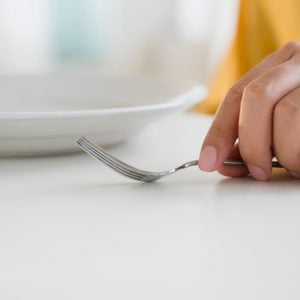What Is Alternate Day Fasting? Schedule, Health Benefits, and More
Updated: Oct. 28, 2020
Here's a beginner's guide to alternate day fasting—you might also know it as the eat-every-other-day diet or the 5:2 plan. This is what to consider
Our editors and experts handpick every product we feature. We may earn a commission from your purchases.
Understanding alternate day fasting
One day you eat whatever you want; the next day you eat almost nothing. That’s the idea behind alternate fasting, a form of intermittent fasting, popular for benefits like weight loss and heart health. Alternate day fasting involves a pattern of feast and fast days, with fast days allowing few to no calories, depending on the plan. There are many different ways to approach alternate day fasting. (This is the difference between alternate day fasting and intermittent fasting.)
Alternate fasting schedule
Some people follow the plan simply by fasting every other day and eating normally in between. Others favor the modified 5:2 approach where you eat whatever you want for five days, then restrict your caloric intake to 500-600 calories on the other two.
Other methods include zero-calorie alternate day fasting where you go back and forth between 12 hours of unlimited eating and 36 hours of no eating. There’s also the Eat-stop-Eat approach, which requires a 24-hour fast just once or twice a week. Learn more about the various alternate day fasting schedules.
Alternate day fasting can be difficult to follow, especially in its strictest forms, explains Krista Varady, PhD, professor of nutrition at University of Illinois, Chicago and author of The Every-Other-Day Diet.
The goal of alternate day fasting is to flip your metabolic switch so your body burns fat instead of stored glucose for energy. This tends to happen within eight to 72 hours, Varady says.
“In eight hours, we start to see ketones in your bloodstream, and this process is a full-blown 24-72 hours.” As the body breaks down fat, ketones begin to build up in your bloodstream. This process is called ketosis and means that your body is burning fat for fuel. Ketones are chemicals your body makes for fuel when you don’t have enough sugar for energy.

Alternate day fasting and weight loss
At about 10 to 15 pounds in three months, alternate day fasting produces more weight loss than other forms of intermittent fasting, says Varady.
Compare this to time-restricted feeding, a form of intermittent fasting that limits the time you can eat to specific windows each day. Time-restricted feeding results in about 6 to 7 pounds of weight loss in three months.
Combining an alternate day fasting approach with a low-carb diet produces 15 percent more weight loss than alternate day fasting alone, she says. With this combination approach, 30 percent of your calories come from carbs on feast days.
The 5:2 method of alternate day fasting produces as much weight loss as the stricter every other day plan, she notes.
“This is a more mild version of alternate day fasting that may be a good choice if you have a lot of weight to lose,” adds Courtney M. Peterson, associate professor, department of nutrition sciences at the University of Alabama at Birmingham.
There was concern that fasters may eat more on feast days and cancel out some of the weight loss benefits, but this hasn’t been the case, Varady says.
“We have shown people only eat 10 percent more on feast days. They don’t go crazy,” she says.
Researchers aren’t exactly sure how these fasts lead to weight loss and other benefits, but studies are continuing.
“It could be because you are eating less food,” Varady says. “There isn’t necessarily anything magical about it. If you cut out 500 calories per day, you will lose weight.”
Health benefits of alternate day fasting
Regardless of which approach you choose, alternate day fasting’s benefits may go well beyond weight loss to include improvements in heart health, reduction in diseases, and possibly an increase in longevity.
May increase longevity
With weight loss comes improvements in other health benefits. In one study, when participants alternated between 36 hours of zero-calorie intake with 12 hours of unlimited eating, they ate 35 percent fewer calories and lost about 7.7 pounds in a month. The study, which appears in Cell Metabolism, showed that fasters continued to burn fat for fuel-even on feasting days. What’s more, fasters showed reduced levels of sICAM-1, a marker of age-related disease and inflammation, and lower levels of the hormone triiodothyronine.
Meanwhile, a study in The Journals of Gerontology: Series A suggests that lower levels of this hormone may increase longevity. The alternate day fasters also had lower levels of cholesterol and less belly fat. Belly fat is considered a dangerous type of fat because it releases inflammatory chemicals that can increase the risk of heart disease, liver disease, diabetes, and other health conditions.
May improve heart health
An alternate fasting diet that leads to weight loss can, in turn, help improve heart health, specifically in people who are overweight and obese. In a small clinical trial, published in The American Journal of Clinical Nutrition, 12 obese women and four obese men saw a drop in body fat, low-density lipoprotein (LDL) “bad” cholesterol levels, total cholesterol, triacylglycerols, systolic blood pressure, and heart rate, after completing a modified 10-week trial of alternate day fasting.
Specifically, after eight weeks, the participants experienced a mean weight loss of 5.8 percent. The researchers concluded following an alternate day fasting diet may be effective in not only helping weight loss, but also protecting heart health in obese individuals.
Improves the body’s response to insulin
In a 2019 study in Obesity, alternate day fasting improved the body’s response to insulin by more than twice as much as a typical calorie-restricting diet. People with diabetes do not produce insulin or become resistant to its effects. When this occurs, blood sugar or glucose levels rise. Insulin resistance is a precursor to type 2 diabetes.
“We see reductions in blood pressure and insulin resistance across studies with all types of fasting,” Varady says, noting that reductions in dangerous blood fats known as triglycerides and “bad” or low-density lipoprotein cholesterol will vary and tend to be more pronounced among people who already have high levels of these blood fats. (Ladies, this may not apply to you. Learn more about the differences in intermittent fasting benefits for women.)
Turns on autophagy
Fasting may also switch on a process known as autophagy, which happens when your body engages in deep cleaning, getting rid of damaged cells, and creating new ones.
“This is anti-aging at the most basic cellular level,” explains Robin Foroutan, RD, integrative medicine dietitian, Morrison Center, New York City and spokesperson for the Academy of Nutrition and Dietetics.
Alternate day fasting: Getting started
Alternate day fasting is harder to follow than other fasts because it can involve counting calories every other day, Varady says. It can also be hard for some people to go for such long periods without eating, she notes. (Here’s how to start intermittent fasting.)
Instead of feeling hungry on fast days, “you should feel a boost of energy,” Varady says. Once your body has adjusted and you feel energetic, it’s OK to restart your exercise regimen, she says. “People often feel a boost of energy on fast days, so exercising is not difficult.”
It takes time to get used to alternate day fasting, but most people adjust within 10 days, Varady says. On fasting days, you can drink as many calorie-free beverages as you like. These drinks include water, tea, and coffee. Some plans allow for a low-calorie diet on fasting days. Ideally, you shouldn’t exceed 500 calories during these days.
During fasting, for meals, it’s best to opt for high-protein foods and low-calorie vegetables to feel fuller with less caloric intake. For example, soups, vegetables, yogurt with berries, and even a salad with some lean meat are acceptable options for meals.
Alternate day fasting: Is it working for you?
Alternate day fasting is not for everyone, and it makes sense to get the green light from your doctor before making any dramatic changes.
Listen to your body, Foroutan urges. “In general, intermittent fasting should have you feeling really good,” she says. If you experience any side effects such as hunger, fatigue, nausea, and headaches, talk to your doctor or a health care professional who knows about fasting to understand why these are occurring and to help you make adjustments. Dehydration, which can occur with fasting, may be driving many of these symptoms.
“Intermittent fasting is not for everyone,” Varady adds. “You need a way of eating that you can stick to for the long term. If you use a diet to lose weight and then go back to your old way of eating, you will gain the weight back.”
Who should avoid alternate day fasting
Fasting is not recommended for women who are pregnant or breastfeeding or are under the age of 25. It’s not recommended if you take insulin or other medications to control diabetes or any medication that must be taken with food, or if you have a seizure disorder like epilepsy. It’s not a good idea if you operate heavy machinery at your job or are at risk for eating disorders or disordered eating.




